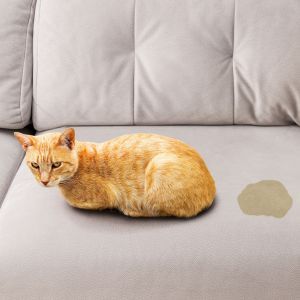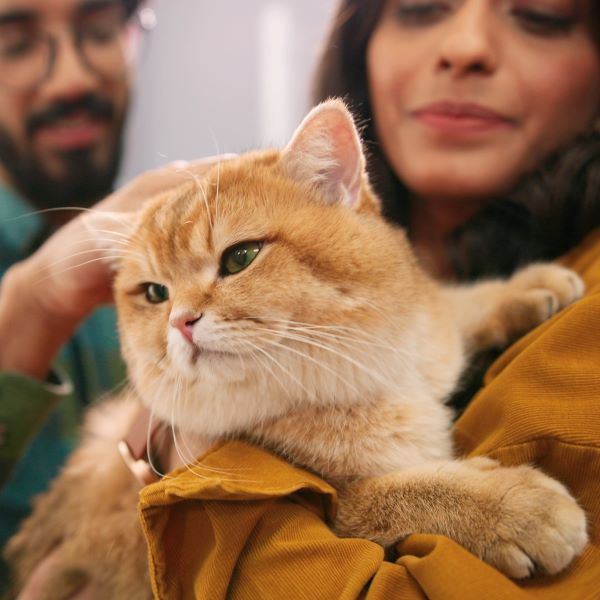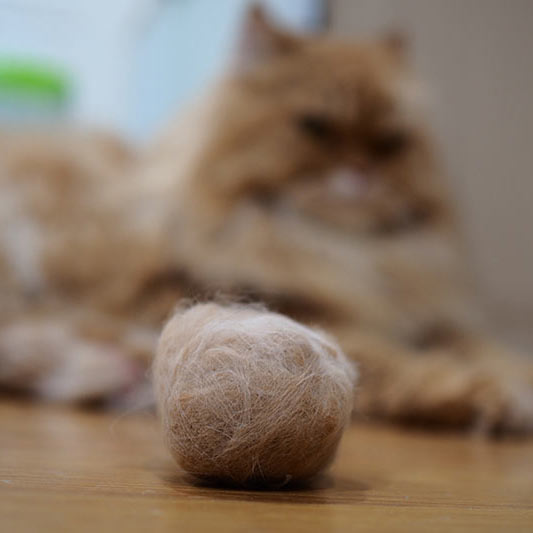Pneumonia in cats
What is pneumonia in cats?
Most of the lung tissue is composed of tiny clusters of alveoli, or air sacs. Each alveolus is lined with a thin layer of cells and surrounded by a network of tiny blood vessels. When breathing in, air comes down the trachea, the large airway that extends from the back of the throat to the lungs, and fills the alveoli. The cells in the lining and vessels of the alveoli exchange oxygen from the incoming air for carbon dioxide, which is then exhaled.
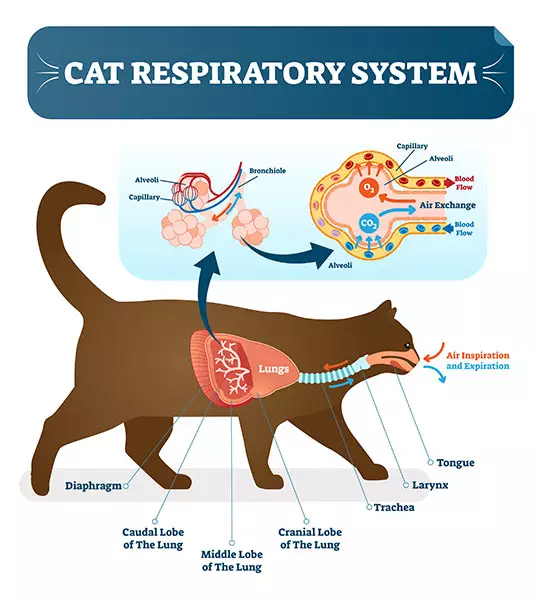
When foreign organisms such as certain bacteria, viruses, and fungal organisms invade the nostrils or trachea, they can cause infection and inflammation. If the infection and inflammation continue down the respiratory tract to infect the alveoli, they can fill with fluid and pus, which limits the lungs’ ability to function effectively. At this point, the cat is said to have developed pneumonia. Pneumonia causes breathing difficulties and oxygen deficiency in the blood, which can have serious systemic effects.
Although all breeds of cats are susceptible to pneumonia, those with brachycephalic (flat-faced) features, such as Persians, Ragdolls, and Himalayans, are more likely to experience upper respiratory tract infections, which may put them at risk for respiratory complications such as pneumonia. While pneumonia tends to be uncommon in healthy adult cats, young, old and ill cats are at increased risk, because they tend to have less effective immune systems to fight off body invaders.
While viral infections of the upper respiratory tract are the most common cause of pneumonia in cats, there are a number of subtypes of pneumonia that occur in cats, depending on the specific cause of the lung infection and inflammation:
Bacterial pneumonia
Bacterial pneumonia refers to an inflammation of the lungs resulting from disease-causing bacteria. This inflammation is characterised by an accumulation of cells and fluid in the lungs, airways and alveoli.
Fungal pneumonia
Fungal pneumonia, also called mycotic pneumonia, is a fungal infection of the lung that leads to the development of pneumonia. A number of fungi have been shown to cause fungal pneumonia in domestic animals. Often these fungi are found in animals with compromised immune systems, but they can cause disease in healthy animals as well. Fungi can enter the body through inhalation via the mouth or the nasal cavity.
Aspiration pneumonia
Aspiration pneumonia is a lung infection in which a cat’s lungs become inflamed because of the inhalation of foreign material, such as from vomiting or regurgitation of gastric acid from the stomach. It can also result if the cat has difficulty in swallowing or problems associated with the oesophagus. The severity of the inflammation depends on the material inhaled and the dispersal of aspirated material in the lungs.
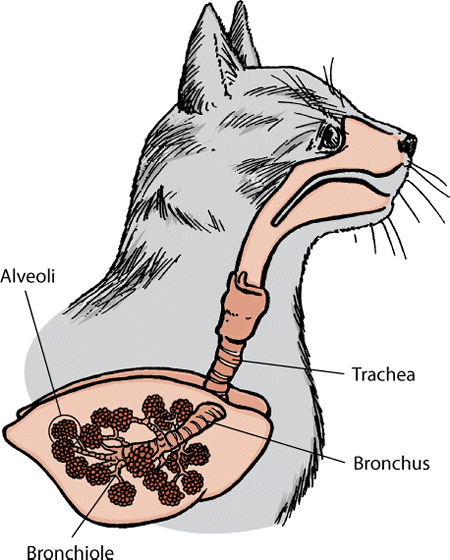
Pneumonia in cats: diagram of cat’s lungs and airways
Source: https://www.msdvetmanual.com/-/media/manual/veterinary/images/ddc_cat_lungs_airways.gif
Symptoms of pneumonia in cats
Pneumonia in cats can be confined to a small area of the lungs, or the disease can spread throughout the lung tissue. Depending on the severity, symptoms can range from relatively mild to severe. The most common symptoms of pneumonia are a cough and difficulty breathing. However, not all cats with pneumonia will display respiratory signs.
Many of the symptoms of pneumonia can also be symptoms of other illnesses. If your cat exhibits these symptoms, a visit to the veterinarian is in order. Because a variety of organisms can cause pneumonia, there may be additional symptoms that are associated with the underlying cause.
Common symptoms of pneumonia in cats include
- Breathing difficulties – shallow, laboured or rapid breathing rate
- Coughing – a dry, hacking cough or a short, moist cough that may bring up mucus or blood
- Loud respiratory sounds (e.g. rattling sound coming from the chest)
- Cyanosis (blue tinge to mucous membranes of the mouth)
- Dehydration
- Exercise intolerance
- Fever – increased body temperature
- Lethargy (tiredness, malaise)
- Nasal discharge (if the upper respiratory tract is involved)
- Poor, unkempt appearance
- Reduced appetite
- Weight loss
Additional symptoms of fungal pneumonia in cats
- Eye problems (often a fungal infection will first present as an eye or skin problem)
- Possible lameness
- Runny eyes or nose
- Skin lesions
Additional symptoms of aspiration pneumonia in cats
- Airway spasms
- Bad breath
- Difficulty swallowing
- Increased heart rate
- Rapid breathing
- Regurgitation
- Runny nose, thick mucus discharge
- Vomiting
Causes of pneumonia in cats
A variety of bacterial, viral, and fungal organisms can cause pneumonia in cats, although the most common cause is primary viral infection of the lower respiratory tract. There are a number of risk factors that may increase the likelihood of a cat developing pneumonia.
Pneumonia may be complicated and exacerbated by multiple factors that cause or contribute to the disease. For example, a virus or fungus can damage the respiratory tract to the extent that a secondary bacterial infection can occur.
Viral pneumonia in cats – causes and contributing factors
- Upper respiratory infections are common in cats, particularly very young, elderly and stressed cats in crowded environments (such as shelters), and these infections can progress into pneumonia.
- Feline calicivirus, feline infectious peritonitis (FIP) virus and herpesvirus are common viral causes of pneumonia in cats.
- Feline Immunodeficiency Virus (FIV) and Feline leukaemia virus (FeLV) both lead to a weakened immune system, which can increase the likelihood of developing pneumonia from bacteria, fungi or aspiration.
Bacterial pneumonia in cats – causes and contributing factors
- Some of the common bacterial causes are Bordetella bronchiseptica, Pasteurella, Streptococcus, Chlamydia felis, Staphylococcus, Yersinia Pestis and Moraxella.
- Chlamydiae bacteria have been identified as a cause of pneumonia in cats that usually develops in association with chlamydial conjunctivitis and rhinitis.
- Bacterial pneumonia can originate from elsewhere in the body or develop secondary to a viral or fungal infection, problems swallowing, regurgitation and metabolic disorders.
Fungal pneumonia in cats – causes and contributing factors
- There are several types of fungi that can cause lung fungal infections, including Cryptococcosis, Blastomyces, Histoplasma and Aspergillus.
- The fungus Cryptococcus tends to colonize in the cat’s nasal cavity where it causes inflammation of the nasal and sinus lining.
- The cat may be exposed to infection-causing fungi through contact with soil that’s rich in organic matter, bird droppings or faeces – inhalation of spores from the soil is thought to be the source of most fungal infections in cats.
Aspiration pneumonia in cats – causes and contributing factors
- A common cause of aspiration pneumonia is the inhalation into the lungs of gastric contents from vomiting or gastric acid from regurgitation.
- Inhalation of a foreign substance, such as a caustic or irritating substance (such as smoke) or a grass awn, is another cause.
- Fluid in the lungs, such as after a near-drowning, is another possible cause.
- Swallowing difficulties and oesophageal obstructions, such as attempting to eat or drink while partially choked.
- Improper intake or force-feeding of liquid medicines and mineral oils (common hairball treatments)
- Pharyngeal, laryngeal, oesophageal, gastric or intestinal abnormalities or diseases, for example, reflux, oesophagitis may increase the likelihood.
- Recent general anaesthesia may increase the likelihood.
- Cats who are chronic vomiters and cats with a cleft palate are more susceptible.
Other medical conditions can increase the likelihood of feline pneumonia, including:
- Untreated respiratory problems
- Heart failure
- Injury to the mucous membranes of the bronchial tubes
- Parasitic invasion of the bronchi, by for example lungworm, toxoplasmosis, liver flukes, roundworms
- Weakened immune system
- Metabolic disorders
- Neuromuscular disorders
- Cancers
How is pneumonia in cats diagnosed?
Diagnosis usually involves a combination of history, physical examination and appropriate tests in order to gain a thorough understanding of the condition of the cat’s lungs and to identify the causal factors involved.
Physical examination and medical history
Obtaining a medical history and performing a physical examination are the first steps in diagnosing pneumonia. The vet will listen to the cat’s chest through a stethoscope to determine whether the breathing sounds in the lungs and airways are normal or whether there are any audible breathing abnormalities, such as crackles (short, snapping sounds), whistling or wheezing.
Further tests are likely to confirm the diagnosis of pneumonia and determine the cause, such as:
Routine blood tests
A complete blood count and chemical blood profile will be ordered. Blood tests will indicate the presence of infection; increased white blood cells are common with bacterial and fungal pneumonia.
Lung aspiration
A needle is inserted through the chest into the lungs and lung cells are aspirated into the syringe. These cells are then examined under a microscope for the presence of infectious organisms.
Tracheal wash
This is performed by inserting a tiny plastic tube into the airways, in order to obtain material such as fluid or cells from the trachea for analysis. The material can be analysed by means of cytology (examination of the cells), culture (to identify bacteria or fungi) and sensitivity test (to determine the bacteria’s sensitivity to an antibiotic).
Blood gas evaluation
If the cat is suffering from respiratory distress, a blood gas analysis may be ordered. This test measures the levels of oxygen and carbon dioxide concentrations in the blood.
Radiography
Chest radiographs (x-rays) will help confirm a diagnosis of pneumonia and are useful in looking for suspected inhaled foreign objects in cases of aspiration pneumonia. In the later stages of pneumonia, chest x-rays can reveal an increase in lung density.
Once the diagnosis of pneumonia is confirmed, additional tests may be performed to help determine the underlying cause and identify the organism(s) responsible for the disease. The symptoms of the subtypes of pneumonia may be similar, and diagnosis must properly determine between them so that correct treatment can be undertaken. These tests may include:
- Faecal examination to look for the presence of parasites
- Blood tests to check for viruses such as FIV and FeLV
- Nasal or eye discharge culture to check for the bacterium pestis (in affected areas)
- Blood test for toxoplasmosis
Diagnosis of bacterial pneumonia
If the vet suspects bacterial pneumonia, the following procedures may be performed to confirm the diagnosis:
- A tracheal wash to obtain material from the lining of the trachea for analysis, which can be cultured to determine the particular organism involved and subjected to a sensitivity test to determine the most effective antibiotic.
- Other tests may include x-rays of the chest and lungs, blood analysis and urine analysis.
Diagnosis of fungal pneumonia
A tentative diagnosis of fungal pneumonia can be made if an animal with chronic respiratory disease shows the typical signs and does not respond to antibiotic therapy, which is effective against bacteria but not against fungi or other organisms. However, a definitive diagnosis requires identification of the fungus using appropriate laboratory tests, which may include:
- A tracheal wash to collect fluid which is analysed to identify the fungus.
- A fine needle aspirate, lumpectomy or biopsy of a skin lesion or an enlarged lymph node, if present, can be performed to identify a fungal infection.
- Other tests may include a urinalysis, x-rays of the chest and lungs, abdominal ultrasound and tests to identify the species of fungus.
Diagnosis of aspiration pneumonia
A history suggesting that a foreign substance might have been inhaled is the most important clue to diagnosing this disease. Other confirming factors may include:
- Evidence of the breathed-in material (for example, oil droplets) in the cat’s nasal discharge or coughed-up material.
- A swallowing study to determine whether there is a dysfunction of the oesophagus.
- An internal fluorescent video x-ray, called a fluoroscopy, to assess the muscles of the oesophagus, and their ability to move food down to the stomach.
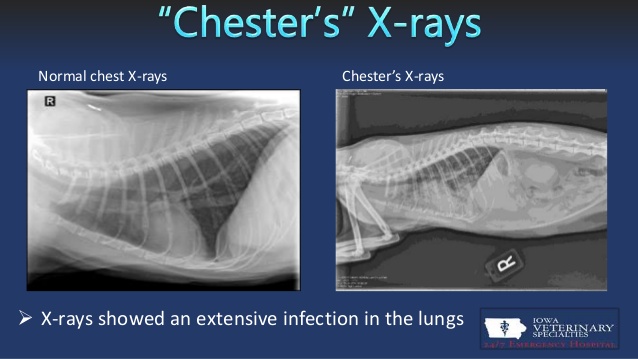
Pneumonia in cats: “Chester’s” x-rays showing an extensive infection in the lungs vs normal chest x-rays
Source: https://image.slidesharecdn.com/chester-140718064923-phpapp02/95/feline-pneumonia-14-638.jpg
Life expectancy
Prognosis for pneumonia is generally good if properly treated. While the outcome depends largely on the underlying cause of the pneumonia and the cat’s overall state of health, it is much more favourable if medical care is sought promptly. While severe pneumonia can be difficult for even a healthy cat to fight off, the very young, very old, and those with another serious health condition are most likely to succumb to the disease.
Most deaths from pneumonia result from secondary complications. If the infection spreads through the body, other organs may become inflamed, affecting their ability to function, which can be fatal. There are two secondary conditions that may result from pneumonia, and which are associated with increased fatalities: hypoxemia (severely low levels of oxygen in the blood) and sepsis (poisons in the blood stream). Additionally, if the underlying cause of the pneumonia is FIP virus or another potentially fatal illness, the cat may recover from pneumonia but die from other complications of the underlying disease.
As with nearly all disease conditions, prevention is better than treatment. This is especially the case for aspiration pneumonia, because the outlook is poor even with treatment. The rate of death is high, and recovered animals often develop lung abscesses.
Treatment for pneumonia in cats
Feline pneumonia is treatable in most cases. The primary aims of treatment for pneumonia are to stabilise the afflicted animal and to treat the pneumonia itself and any underlying conditions that are causing or contributing to it. Treatment can take several weeks to be successful.
Stabilisation of the animal:
- Hospitalisation may be required in more severe cases and the cat may need to be in intensive care for several days before it is fully stabilised.
- If the mucous membranes are very bluish, indicating poor oxygen in the blood, the vet may administer oxygen.
- If the cat is in respiratory distress, oxygen therapy or a nebuliser may be provided.
- If there are signs of dehydration or shock, or if intake of oral fluids has been prohibited, an intravenous drip may be inserted and IV fluids may be administered.
- Nutritional support if the cat is not eating, for example, strong smelling food, appetite stimulants or a feeding tube.
Treating the pneumonia:
- Antibiotics are often prescribed to begin treating bacterial infections while additional test results are pending.
- Once laboratory cultures have been completed, the treatment may be modified so that the drugs given best match the type of infection found.
- Multiple medications may be needed to treat the infection, including antibiotics, drugs to help open the airways and a nasal decongestant to help clear away mucus.
Treatment of fungal pneumonia
- Antifungal drugs are used to treat fungal pneumonia – the precise treatment depends on the type of fungus that has caused the infection.
- Extended drug therapy, often continuing for several months after symptoms have disappeared, is usually necessary to effectively treat the fungal infection.
- Unfortunately, some cats are unresponsive to fungal pneumonia medication.
Treatment of bacterial pneumonia
- Antibiotic therapy will be needed in confirmed cases of bacterial pneumonia.
- The most appropriate medication can be selected from the results of the bacterial cultures and sensitivity tests.
Treatment of aspiration pneumonia
- If possible, airway suctioning should be performed immediately following the inhalation of foreign matter.
- If a cat is known to have inhaled a foreign substance, broad-spectrum antibiotics are usually prescribed without waiting for signs of pneumonia to appear.
- Surgical treatment may be required, for e.g. bronchoscopy to remove a foreign object or surgery to correct a cleft palate.
Other treatment options:
- If specific bacteria, viral, or fungal organisms are identified, additional medications may be prescribed to address the infection, for example:
- Anti-parasitic medications to treat worms and flukes
- Antiviral medication to treat viral infections
- Additional treatment may depend on the symptoms and their severity, for example if anorexia, high fever, and weight loss have occurred, these will most likely be actively treated in a hospital.
- The vet may also recommend repeating chest x-rays periodically to monitor how well the pneumonia is resolving.
Preventative measures
- Routine vaccination and regular wellness exams can help in the prevention of pneumonia and other infectious diseases.
- Prevention of severe pneumonia is possible with early treatment of any signs of respiratory disease. This is especially true for brachycephalic breeds and cats with pre-existing underlying diseases.
- To prevent a recurrence of pneumonia, the cat may need to be re-examined frequently, including periodic chest x-rays, to monitor the lungs, to follow an underlying disease (if present), or to detect any possible complications.
- Aspiration pneumonia is a life-threatening condition with a relatively poor prognosis, therefore it is essential to see the vet immediately if there is any indication that your cat may have aspirated foreign matter.
- Vets usually use drugs and other precautions to minimise the risk of an animal inhaling fluid (such as saliva) during surgery.
Recovery from pneumonia in cats
Recovery from feline pneumonia requires plenty of rest in a warm, quiet environment. Confine the cat to a small area or cage, away from other animals and children. To avoid fluid build-up on one side of the lungs, ensure your cat changes position frequently while resting. Restrict exercise during recovery. Once your cat is stable, exercise should be limited to physiotherapy and mild exercise that will stimulate coughing to help clear the airways.
Always follow your veterinarian’s instructions and give all medications as prescribed, continuing the full course until completed. After initial treatment, the vet may recommend that you feed your cat a diet high in protein and energy density. Your cat will need to have a follow-up appointment and procedures such as repeat chest x-rays and blood tests.
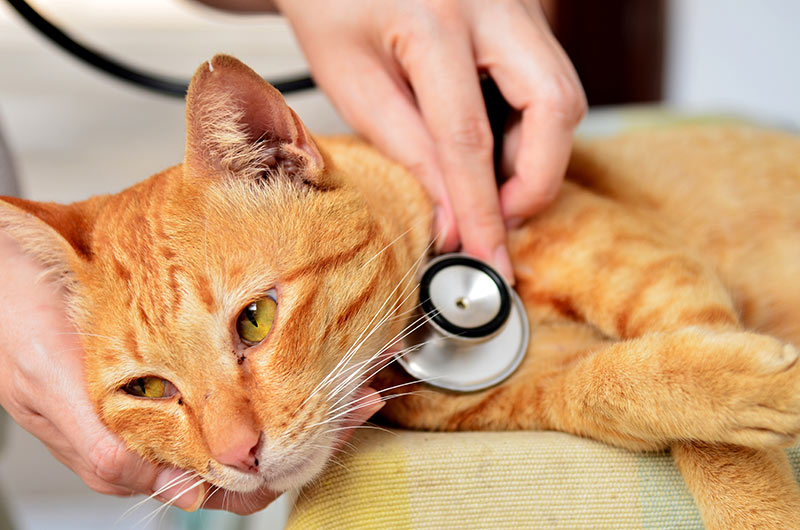
Overview
Pneumonia is an infection of the lungs that in cats is usually caused by a bacterial, viral or fungal infection or aspiration (inhalation of food, water or medicine). Cats frequently develop upper respiratory conditions that can lead to pneumonia, especially young, old and ill cats. Symptoms include fever, coughing, runny nose, breathing difficulties such as rapid, rattling, laboured or loud breathing, and a loss of appetite.
Feline pneumonia can be a life-threatening illness, so if you notice any respiratory symptoms in your cat, make an urgent appointment with your vet. Diagnostic techniques for pneumonia may include lung aspiration, tracheal wash and x-rays. Medications to treat the underlying cause (antibiotics, antivirals or anti-fungals) and supportive care are usually recommended. In more severe cases, hospitalisation will usually occur so that the cat can be supported and monitored during treatment.
Recovery will depend on the cause and severity of your cat’s pneumonia. Some cases of pneumonia are complicated by multiple invading organisms. A virus or fungus can do the initial damage, weakening the cat so that a secondary bacterial infection takes hold.
Many cats have a full recovery from pneumonia when diagnosed and treated appropriately and promptly. Keeping your cat current on vaccinations and in general good health is the best prevention for this disease.
Bow Wow Meow Pet Insurance can help protect you and your cat should an unexpected trip to the vet occur.
-
Find out more about our cat insurance options
-
Get an online pet insurance quote
Bow Wow Meow is proud to have been awarded winner of Canstar’s ‘Most Satisfied Customers’ Award in the Pet Insurance category for both 2024 and 2025!
Bow Wow Meow is proud to have been chosen as Product Review’s Pet Insurance Award Winner every year from 2018 to 2025! This is based on 2,995 independent customer reviews (as at 21/01/2025), with an overall rating of 4.3*
Google Review rating = 4.5* (based on 968 reviews)
Trust Pilot rating = 4.6* (based on 531 reviews)
Bow Wow Meow is proud to have been chosen as Product Review’s Pet Insurance Award Winner every year from 2018 to 2025! This is based on 2,995 independent customer reviews (as at 21/01/2025), with an overall rating of 4.3*
Google Review rating = 4.5* (based on 968 reviews)
Trust Pilot rating = 4.6* (based on 531 reviews)
Bow Wow Meow has been chosen as a winner in the Finder Pet Insurance Awards 2024. Finder’s panel of experts analysed over 140 quotes to award our Ultimate Care Plan the winner of the “Pet Insurance – Value” category.
More Information
http://www.vetstreet.com/care/pneumonia-in-cats
http://www.vetstreet.com/dr-marty-becker/feline-pneumonia-what-you-need-to-know
https://www.msdvetmanual.com/cat-owners/lung-and-airway-disorders-of-cats/pneumonia-in-cats
https://www.petmd.com/cat/conditions/respiratory/c_ct_pneumonia_bacterial
https://www.petmd.com/cat/conditions/respiratory/c_ct_pneumonia_aspiration
https://www.cat-world.com.au/pneumonia-in-cats.html
https://healthypets.mercola.com/sites/healthypets/archive/2017/12/19/cat-pneumonia.aspx

